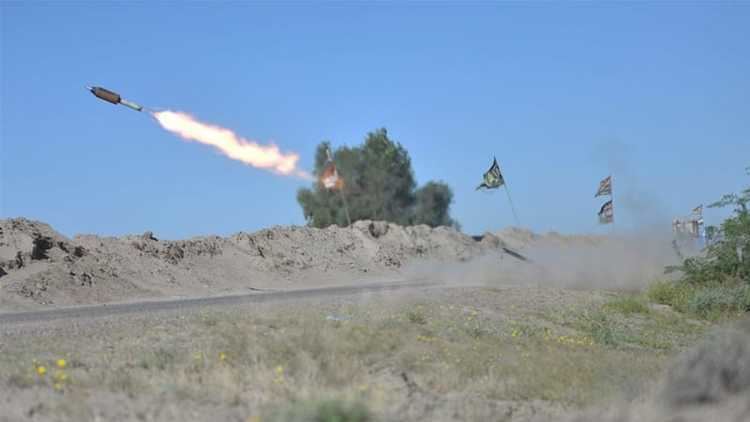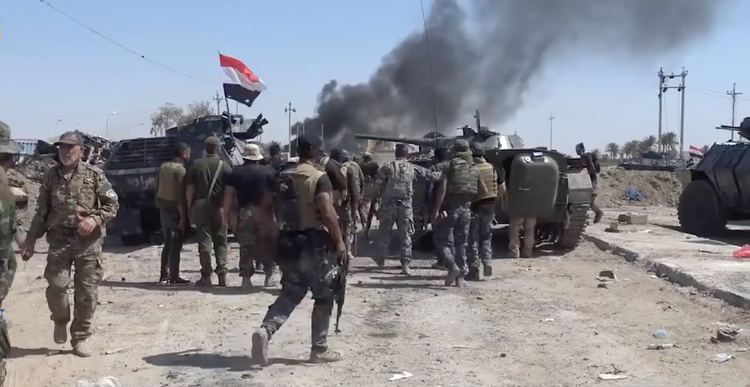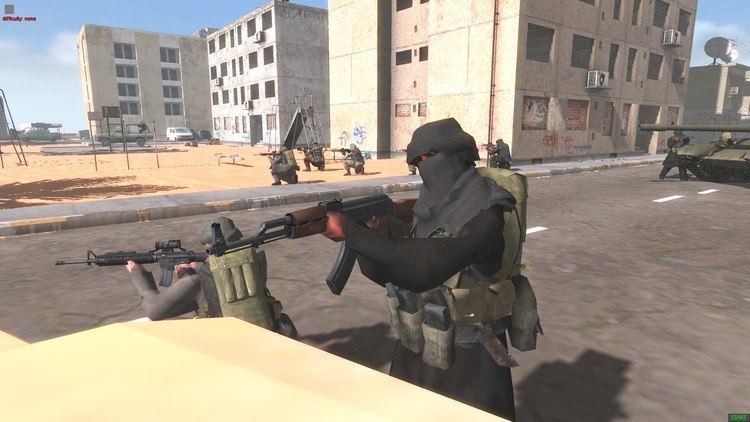Start date May 22, 2016 | Result Iraqi government victory | |
 | ||
11,000–14,500 fighters
7,000–10,500 Iraqi soldiers
4,000 PMF militiamen 3,500–4,000 militants
600~ Militants
(ISIL claim) 394–900+ killed,
3,308 wounded
3,000+ killed
(ISIL claim) 2,500+ killed,
2,186 captured Similar Second Battle of Fallujah, Battle of Baiji (2015), Battle of Ramadi (2014–15), Battle of Ramadi (2015–16), Sinjar massacre | ||
The Battle of Fallujah (2016), also referred to as Third Battle of Fallujah, or Fallujah offensive (2016), code-named Operation Breaking Terrorism (Arabic: عملية كسر الإرهاب) by the Iraqi government, was a military operation against ISIL launched to capture the city of Fallujah and its suburbs, located about 69 kilometers (40 miles) west of the Iraqi capital Baghdad. The operation began on 22 May 2016, three months after the Iraqi forces had started the total siege of Fallujah. On 26 June, Iraqi forces recaptured the city of Fallujah, before recapturing the remaining pocket of ISIL resistance in Fallujah's western outskirts two days later.
Contents

Background

Fallujah was the first city seized by ISIL in Iraq in January 2014. Iraqi forces completely surrounded the western city after they recaptured Ramadi in February 2016. ISIL militants prevented people from leaving the city.
Fallujah was considered to be the second most important stronghold of ISIL in Iraq, after Mosul.
Preparations

The Iraqi Army published a statement on 22 May 2016, and asked residents of the battlefield to leave the area through secured routes. The Iraqi Army also said that local residents who could not move should raise white flags on top of their roofs.
Shia marja' Ayatollah Sistani released instructions regarding respecting moral principles while advancing toward the Sunni city.

Prior to the Battle of Fallujah, some Shia militias framed the impending campaign using extreme rhetoric, referring to the city as a "tumor" to be eradicated, as "Fallujah the whore," and as a “nest of traitors and criminals.” The fight to retake Fallujah was often portrayed sectarian terms: for instance, one Shia militia launched rockets at the city painted with the word “Nimr” – referring to Nimr al-Nimr, the Shia cleric executed by Saudi Arabia earlier this year.
Capturing the outskirts

Haider al-Abadi ordered to begin the operation early on Monday, 23 May. "The Iraqi flag will be raised high over the land of Fallujah," said al-Abadi. On 23 May 2016, it was reported the city of Al-Karmah was recaptured by Shiite militias belonging to the Popular Mobilization Forces (PMF). Photos published by a PMF source show Iran's Quds Force commander Qassem Suleimani and other PMF commanders discussing Fallujah battle strategies. On the first day of the offensive 11 further villages and districts near Fallujah were recaptured, which forced ISIL fighters to retreat to the interior of the strategically important city. The offensive was slowed down due to the discovery of hundreds of improvised explosive devices in the outskirts of the city.
The Popular Mobilization Forces declared on 23 May that they had captured Al-Karmah, about 16 kilometers (10 miles) northeast of Fallujah, which brings most of the territory east of Fallujah under Iraqi government control. They also announced the seizure of al-Harariyat, al-Shahabi and al-Dwaya and the killing of 40 ISIL militants during the military operation. The Iraqi government announced that pro-government fighters had captured the villages of Luhaib and Albu Khanfar on 24 May.
On 23 May, 16 villages and districts on the eastern outskirts of Fallujah had been cleared by the Iraqi Security Forces. Included in this were the gains from a column in the northeast, which took the village of Sejar days after the recapture of Al-Karmah. These clashes resulted in the death of 40 ISIL militants. By 25 May, a total of 163 ISIL militants, 15 civilians and 35 Iraqi forces and militiamen were killed in clashes which gained the Iraqi army control over the remaining districts in the southeast, allowing them to create a corridor that cut the ISIL-controlled zone in two. During the day, it was reported an Iranian Basij member was killed in fighting near Fallujah. According to Qasm Araji, a member of the defense committee, the advancing forces are continuously gaining ground and "nearing Fallujah’s Eastern gate."
On 27 May, the US-led Coalition conducted airstrikes in and around the city. US-led Coalition air and artillery strikes in and around Fallujah killed 70 ISIL fighters in Fallujah, including the militants’ top commander in the area, Maher Al-Bilawi. On 28 May, the Iraqi Army declared the start of an operation to take Fallujah’s city center. Iraq's Counter-Terrorism Service (CTS) was the first unit to break into the city.
On 29 May, the Iraqi forces reportedly repelled an ISIL attack on Albu Shajal, killing "dozens" of militants. On the same day, Iraqi troops seized a key bridge between Zaghareed and Saqlawiyah, in order to facilitate the entry of the security forces from the international highway road into the center of Saqlawiyah.
Battle for Fallujah city
Early on 30 May, the Iraqi forces began entering the city of Fallujah from three directions and captured the village of Saqlawiyah. However, the Iraqi forces faced very stiff resistance from the ISIL forces inside of the city, slowing their advance. By 31 May, only 3,000 civilians had managed to escape Fallujah. The Iraqi forces entered Fallujah city through the southern village of Nuamiyah, entering the Shuhadaa neighborhood, on the way to the city center. Iraqi forces repelled a four-hour attack by the Islamic State in the south of the city of Fallujah on Tuesday. The militants deployed snipers and six cars carrying explosives which were destroyed before reaching the troops.
The Iraqi Army's advance into Fallujah was stalled on Wednesday, 1 June, due to fierce resistance from Islamic State fighters and concerns over protecting tens of thousands of civilians still trapped inside the strategic city, officials said. Civilians, including families, were moved to the city center and used as human shields by ISIL. With the operation in its second week, convoys of special forces could only inch forward on the dusty southern outskirts of the city as a handful of airstrikes sent up plumes of white smoke above clusters of low buildings on the fringes of the city's dense urban terrain.
The Fars News Agency reported that, due to the offensive, ISIL commanders had moved cash and jewelry worth US$8 million from Fallujah to the more secure region of Mosul.
On 2 June, the commander of Fallujah operations, Lieutenant General Abdel Wahab al-Saadi, reported further advances of Iraqi forces and the killing of 50 ISIL members in the areas of al-Shuhadaa and al-Nuaimiya in southern Fallujah. In addition, 12 ISIL militants were killed and four vehicles and a mortar detachment destroyed by international coalition aviation in the area of Falahat west of Fallujah.
On 3 June, Iraqi forces moved into a southern neighbourhood of Fallujah. "The security forces have advanced from Naimiya neighbourhood to Shuhada," Lieutenant General Abdelwahab al-Saadi, the operation's overall commander, told AFP. On the same day, Shi'ite militias uncovered a 6-kilometer-long (4 mi) tunnel in Saqlawiyah, linking the town to Fallujah, which had been used by ISIL militants to stall the offensive and evade airstrikes. On 4 June, Iraqi forces captured the town of Saqlawiyah and stormed a neighborhood in southern Fallujah. A Coalition airstrike killed all the ISIL militants trying to escape from Saqlawiyah on a raft. According to reports, 70 ISIL terrorists were killed during the capture of Saqlawiyah, including several foreign combatants. By 5 June, Iraqi forces had secured the southern edge of Fallujah, capturing the Naymiah neighborhood. A leader of the Popular Mobilization Units said that part of the western bank was the only area of Fallujah's outskirts that hadn't been secured by pro-government forces. Iraqi forces captured the neighbourhood of Al-Shuhada Al-Thaniya on 8 June. Five members of the Iraqi security services were injured during the fighting on that day. The move to capture the outlying area went quickly and forced Islamic State fighters to retreat into the heart of the city, the spokesman, Sabah al-Noman, told state television. Government forces were regrouping before beginning their next advance, he added.
On 10 June, Iraq's elite counter-terrorism service reportedly moved within three kilometers of central Fallujah, and consolidated positions in the south of the city.
ISIL attacked a military barracks to the east of Fallujah on 11 June. Fifty members of the Iraqi military and allied Shiite paramilitaries and 12 members of ISIL were killed in the attack. Meanwhile, government forces reached Street 40, two miles from Fallujah's city center.
On 12 June, the Iraqi Army said that it had secured the first safe exit route for civilians to leave the Islamic State's besieged stronghold of Fallujah, and the aid group Norwegian Refugee Council said thousands of people had already used it to flee on the first day it was open. The new exit route, known as al-Salam (Peace) Junction, was secured on Saturday, southwest of Fallujah, Joint Operation Command spokesman Brigadier Gen. Yahya Rasool told Reuters. "There were exit routes previously, but this is the first to be completely secured and it's relatively safe," said Rasool. About 4,000 people had fled the city over the past 24 hours through the al-Salam Junction, said Karl Schembri, a spokesman in Iraq for the Norwegian Refugee Council, which has been assisting people who escape the city.
On 13 June, 546 militants who were fleeing the city disguised as civilians were arrested by the Iraqi military.
Iraq’s police chief said on 14 June that the forces cleared the Fallujah Barrage of ISIL forces and hoisted the Iraqi flag on the crest of the dam. Brigadier Shakir Jawdat said Iraqi forces are now in full control of the barrage, which is located south of Fallujah on the Euphrates River. The Iraqi forces also seized control over three villages of Za’anatha, Ziban and Atr east of Fallujah. They also recaptured Abbas Jamil Bridge to facilitate the advance on the eastern neighborhoods of the city.
On 16 June, the Federal Police announced it had retaken 25% of the city, capturing al-Khadra, al-Resala, Jubail, Fallujah Barrage, Nazim, al-Shuhada, the sewage station and a gas factory during the current phase to retake the city, during which 232 more ISIL militants were killed. On the same day, Lt. Gen. Raed Shaker Jawdat of Iraqi Federal Police said that ISIL militants had begun a "mass escape" from the city to areas of Halabisa and Albu Alwan west of Fallujah. He saw a "total collapse" among the ranks of ISIL. On the same day, Iraqi army started advancing from Fallahat vicinity to those areas in the western axis of Fallujah, killing 20 ISIL members and opening three routes for the passage of tanks and armored vehicles. At the same time, 900 families were evacuated.
The government headquarters of Fallujah was captured by Iraqi forces on 17 June, after they retook several of the city's neighbourhoods in quick succession. During the battle, they faced little resistance from ISIL militants. The operation's commander Lieutenant General Abdulwahab al-Saadi claimed that Iraqi forces were in control of 70% of the city. In the evening of 17 June, the Iraqi army reported on state television that Fallujah had been fully liberated, though the commander of special forces reported that 80 percent of the city had been recaptured, with ISIL fighters concentrated in four northern districts. Fighting was also still going on at nearby central hospital. On Iraqi state television, Prime Minister Haider al-Abadi congratulated the troops on their victories. The central hospital was recaptured by Iraqi forces on 18 June. The following day, the UN stated that about 80,000 civilians had managed to flee the city in the previous four weeks, many after ISIL reversed its policy of preventing civilians from escaping in mid-June. From 18 to 19 June, it was also reported that the remaining ISIL forces in Fallujah were beginning to collapse. On 19 June, it was reported that 50 ISIL militants had been killed in coalition air strikes and 15 others had been killed in clashes with Iraqi security forces. Also, more than 300 soldiers had died over the previous two days.
Later on 21 June, a US commander claimed that Iraqi forces had only cleared 30% of Fallujah of ISIL militants, with fighting still going on in other areas. Iraqi forces captured the police district of Shurta and the military district of Askari by 21 June. The capture of the districts left only the neighborhoods of Golan and Jughaifi as well as the outlying part of Fallujah on the western bank of the Euphrates river under ISIL control. Brig. Gen. Haider al-Obeidi told the Associated Press that 2,500 militants had been killed during the operation and the districts of Shurta and Jughaifi were captured by Iraqi forces by 22 June.
On 23 June, al-Obeidi claimed that Iraqi forces were in control of 90% of the city. Clashes were still ongoing with ISIL as Iraqi forces made no significant advancement during the day. ISIL was in control of only the Golan neighborhood and a few scattered pockets. The last of the ISIL fighters were reported to be in Jolan and Al-Mualemin neighborhoods. The neighborhood of Al-Mualemin was fully captured and cleared of ISIL militants on 25 June. Iraqi forces also raised the Iraqi flag on a medical centre they captured in the Jolan neighborhood.
On 26 June, Iraqi forces recaptured the rest of Fallujah, with an Iraqi commander stating that the entire city was under Iraqi control and declared the operation was over.
A Joint Operations Command spokesperson confirmed the full capture of the city and added that fighting was ongoing against pockets of ISIL resistance northwest of Fallujah. Iraqi Prime Minister Haider al-Abadi visited Fallujah after its recapture. In a televised address, Abadi appeared outside Fallujah's main hospital waving an Iraqi flag and urged Iraqis to celebrate the day of Fallujah's recapture from ISIL.
On Monday, 27 June, the Iraqi Army entered advanced into Fallujah's western outskirts, to eliminate Islamic State militants holed up in the farmland west of Fallujah, to keep them from launching counterattacks on the city a day after Baghdad declared victory over ISIL there. Backed by airstrikes from the U.S.-led Coalition, Iraqi artillery bombarded targets, as troops closed in on up to 150 militants in areas along the southern bank of the Euphrates River Colonel Ahmed al-Saidi, who participated in Monday’s advance, said ground forces were moving cautiously to avoid triggering roadside bombs planted by ISIL. “They (holed-up militants) have two options: either they surrender or they get killed. We want to prevent them catching their breath and attacking our forces with car bombs.” Early on 28 June, the Iraqi Government reported that 80% of areas of al-Halabisa, Albu Alwan and Albu Herat had been recaptured. Later on the same day, the Iraqi Army captured the Halabisa and Albu Alwan areas, fully recapturing Fallujah's western suburbs.
Aftermath
On 29 June, Iraqi jets targeted a convoy of militants and their supporters fleeing from Fallujah's villages under cover of a dust storm. The Iraqi air force claimed that about 426 vehicles carrying up to 2,000 militants were hit in the airstrikes.
Later that day, the U.S. air force conducted airstrikes against ISIL positions on the outskirts of Fallujah, resulting in the death of at least 250 militants and destroying 40 vehicles. Overall, 348 militants were killed and more than 200 vehicles destroyed throughout the day.
He added that 450 vehicles belonging to the extremists were also destroyed in the process.
Separately, Khamis al-Issawi, a Lawa al-Amiriyah al-Samoud tribal leader, said his fighters and security forces had destroyed an ISIL base on the fringes of Amiriyah Fallujah, noting that three tribesmen had been killed and six others injured during the clashes with ISIL militants.
The Federal Police Command announced on Saturday dismantling a large laboratory for booby-trapped vehicles and manufacturing of explosives in central Fallujah. The laboratory contained tons of explosives, it added.
The Federal Police Chief Lieutenant General Raed Shaker Jawdat said, “Today the security forces discovered a large laboratory for booby-trapped vehicles and explosives’ manufacturing at Nezal in central Fallujah during the search operations carried out in the liberated areas." "The booby-trapping laboratory that was found in Nezal was completely dismantled, while tons of explosives and detonators were found inside it,” Jawdat added.
Anbar Provincial Council informed that the security forces secured the old road that links Ramadi with Fallujah and this will be used for the movement of military convoys only. Member of the security committee in Anbar Provincial Council Rajee Barakat al-Eissawi, in said, “The security forces secured the old road linking Ramadi and Fallujah. The road was secured after liberating some areas in Khalidiya from ISIS control.”
Eissawi added, “The security forces managed to liberate the international highway three days ago and managed to open the old road that extends to 44 km towards the new bridge of Fallujah.”
